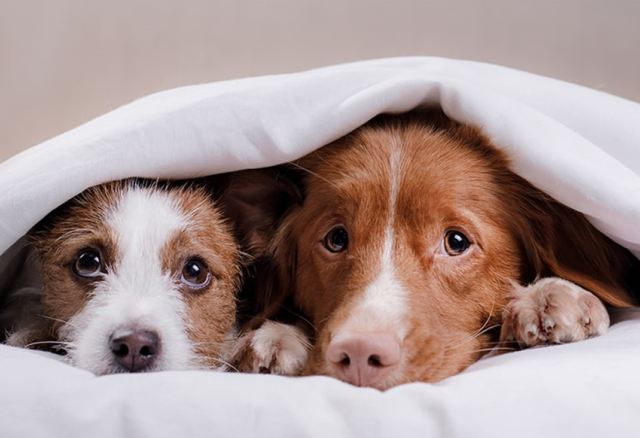As we approach Mental Health Awareness Week (9-15 May), many of us will take some time to evaluate our wellbeing – but what about our precious pets?
We all know how important it is to keep our mental health in check, but sadly our pets can also be affected by stress and anxiety. Our furry friends may not be able to talk about how they’re feeling, but PDSA Vet Claire Roberts has shared some top tips for spotting signs of stress and ways we can help our pets live a happy, heathy life.
Spotting the signs of stress in pets
“Common signs of stress include changes in behaviour, low energy or a lack of appetite. If your dog is in a stressful situation, you may see them yawning, licking their nose or lips, or panting even though they’re not warm. Their body may appear tense with a tucked tail or they may try to hide or move away. In some cases, if stress is ongoing, they may start displaying unwelcome, destructive behaviour or toilet in strange places.
Cats can also behave differently when stressed, with tense bodies, a puffed tail or an arched back. With longer-term stress they may hide away, eat less, and toilet in places other than their litter tray. Cats can even become physically unwell as a result of stress, with some developing stress induced cystitis and other conditions. Rabbits and other small pets aren’t immune to stress and anxiety either and as prey animals they can be very good at hiding it. Signs to watch for in rabbits can include flattened ears, a tense body or a lack of nose twitching.
Whatever pet you have, make sure you’re meeting their five welfare needs to help reduce the chances of them becoming overwhelmed.
Quality time
“Companionship is one of a pet’s five welfare needs and an essential part of our pets’ overall wellbeing, so we must take some time each day to give them our love and attention in a way which our pet enjoys. It can be difficult to prioritise quality time in between busy schedules but exercise and playtime are so important – this helps your pet to burn built up energy and keeps them mentally stimulated, in turn leaving them relaxed and happy.
Creating a safe space
“Just like we may have a favourite place to relax, our pets need their own space where they feel safe and secure, especially when we’re out of the house. This could be a den, crate (if crate trained), box or bed – just ensure it’s in a quiet place with access to food and water and plenty of room to move around. Cats will often prefer a safe spot somewhere high up and rabbits will feel happiest if they have places to hide away that they can easily escape to.
“Leaving on background noise such as a radio can also help some pets to feel more relaxed if you have to leave them alone for longer periods, but remember that dogs shouldn’t be left alone for any longer than four hours at a time.
Consistency is key
“Sticking to a consistent routine is a great way to reduce our pets’ stress, so try to stick to their regular feeding and exercise routines wherever possible. It’s best to gradually implement any big changes, such as a new job schedule, to allow your pet to adjust to the shift in their daily lives.
If your pet is showing persistent signs of stress then ask your vet for professional advice or speak to an accredited behaviourist.
For more information on supporting all aspects of your pet’s health, visit www.pdsa.org.uk/your-pet-care
PDSA is the UK’s largest vet charity providing a vital service for pets across the UK whose owners struggle to afford treatment costs for their sick and injured pets. For many vulnerable pets, PDSA is there to help when there is nowhere else for their owners to turn.




